7346THS: Analysis of Learning in Industry Practicum
VerifiedAdded on 2022/09/23
|11
|2949
|30
Report
AI Summary
This report analyzes learning processes in both classroom and workplace settings, focusing on the context of a practicum. It begins by defining learning and then compares and contrasts formal classroom learning with non-classroom learning, highlighting similarities and differences. The report then identifies various ways learning can occur in workplaces, such as coaching, collaboration, apprenticeship, and role-playing, while also exploring strategies to maximize these learning opportunities. These strategies include aligning interests, modeling behavior, evaluating strengths and weaknesses, adapting learning styles, and recognizing success. The analysis emphasizes the interconnectedness of classroom and workplace learning, stressing the importance of lifelong learning for professional development and adapting to technological advancements. The report draws on multiple sources to support its claims, and concludes with a reiteration of the value of both types of learning for skills and knowledge development.
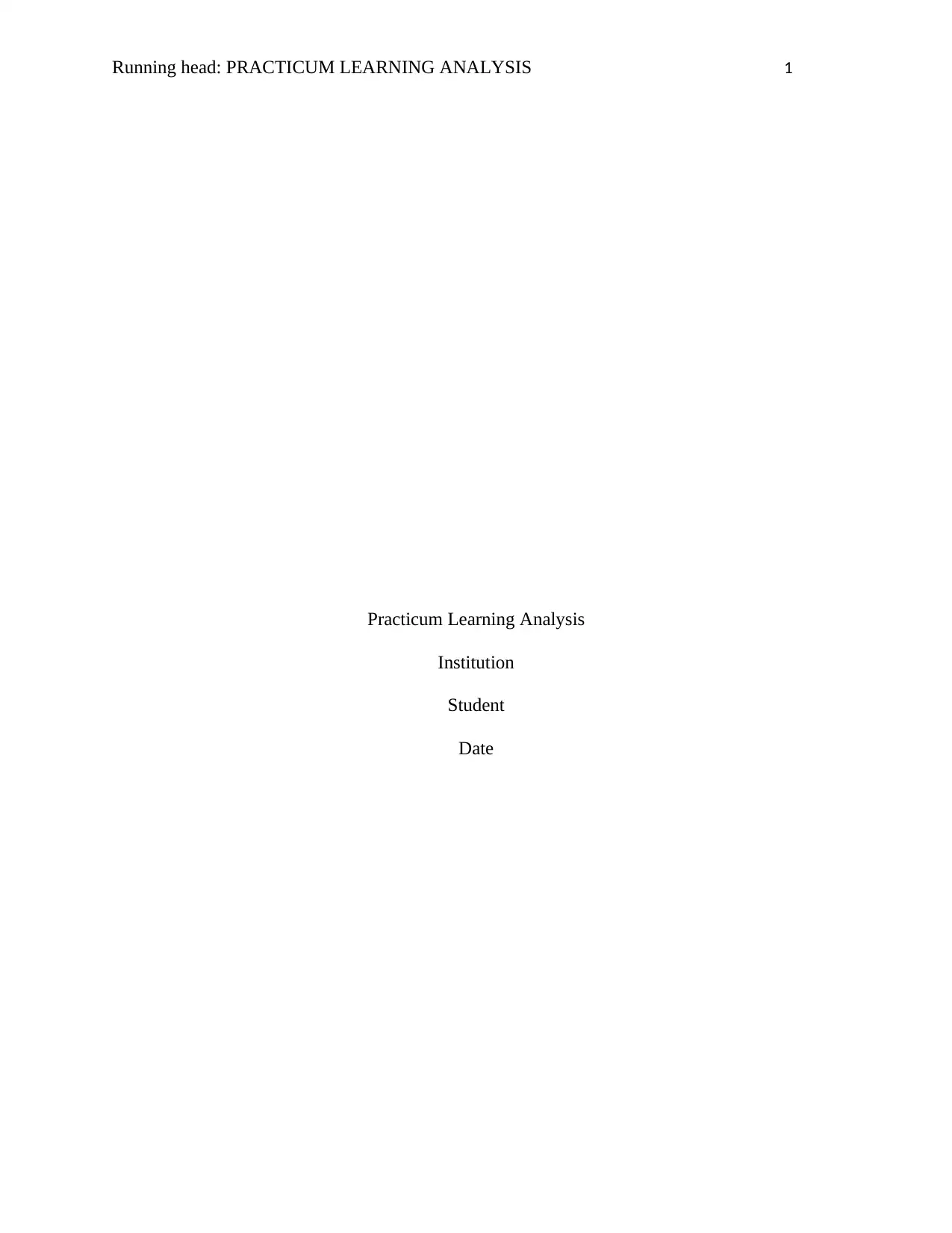
Running head: PRACTICUM LEARNING ANALYSIS 1
Practicum Learning Analysis
Institution
Student
Date
Practicum Learning Analysis
Institution
Student
Date
Paraphrase This Document
Need a fresh take? Get an instant paraphrase of this document with our AI Paraphraser
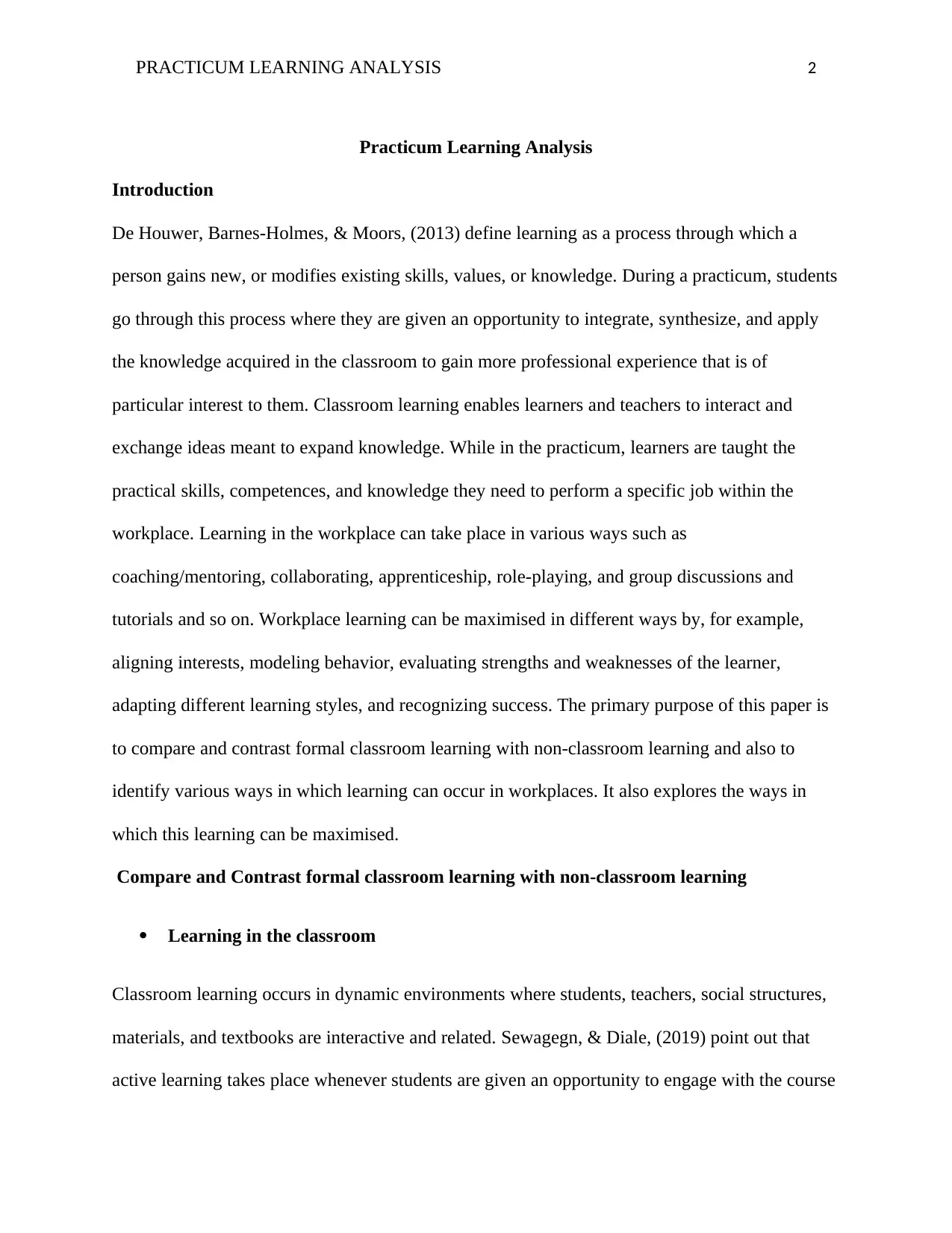
PRACTICUM LEARNING ANALYSIS 2
Practicum Learning Analysis
Introduction
De Houwer, Barnes-Holmes, & Moors, (2013) define learning as a process through which a
person gains new, or modifies existing skills, values, or knowledge. During a practicum, students
go through this process where they are given an opportunity to integrate, synthesize, and apply
the knowledge acquired in the classroom to gain more professional experience that is of
particular interest to them. Classroom learning enables learners and teachers to interact and
exchange ideas meant to expand knowledge. While in the practicum, learners are taught the
practical skills, competences, and knowledge they need to perform a specific job within the
workplace. Learning in the workplace can take place in various ways such as
coaching/mentoring, collaborating, apprenticeship, role-playing, and group discussions and
tutorials and so on. Workplace learning can be maximised in different ways by, for example,
aligning interests, modeling behavior, evaluating strengths and weaknesses of the learner,
adapting different learning styles, and recognizing success. The primary purpose of this paper is
to compare and contrast formal classroom learning with non-classroom learning and also to
identify various ways in which learning can occur in workplaces. It also explores the ways in
which this learning can be maximised.
Compare and Contrast formal classroom learning with non-classroom learning
Learning in the classroom
Classroom learning occurs in dynamic environments where students, teachers, social structures,
materials, and textbooks are interactive and related. Sewagegn, & Diale, (2019) point out that
active learning takes place whenever students are given an opportunity to engage with the course
Practicum Learning Analysis
Introduction
De Houwer, Barnes-Holmes, & Moors, (2013) define learning as a process through which a
person gains new, or modifies existing skills, values, or knowledge. During a practicum, students
go through this process where they are given an opportunity to integrate, synthesize, and apply
the knowledge acquired in the classroom to gain more professional experience that is of
particular interest to them. Classroom learning enables learners and teachers to interact and
exchange ideas meant to expand knowledge. While in the practicum, learners are taught the
practical skills, competences, and knowledge they need to perform a specific job within the
workplace. Learning in the workplace can take place in various ways such as
coaching/mentoring, collaborating, apprenticeship, role-playing, and group discussions and
tutorials and so on. Workplace learning can be maximised in different ways by, for example,
aligning interests, modeling behavior, evaluating strengths and weaknesses of the learner,
adapting different learning styles, and recognizing success. The primary purpose of this paper is
to compare and contrast formal classroom learning with non-classroom learning and also to
identify various ways in which learning can occur in workplaces. It also explores the ways in
which this learning can be maximised.
Compare and Contrast formal classroom learning with non-classroom learning
Learning in the classroom
Classroom learning occurs in dynamic environments where students, teachers, social structures,
materials, and textbooks are interactive and related. Sewagegn, & Diale, (2019) point out that
active learning takes place whenever students are given an opportunity to engage with the course
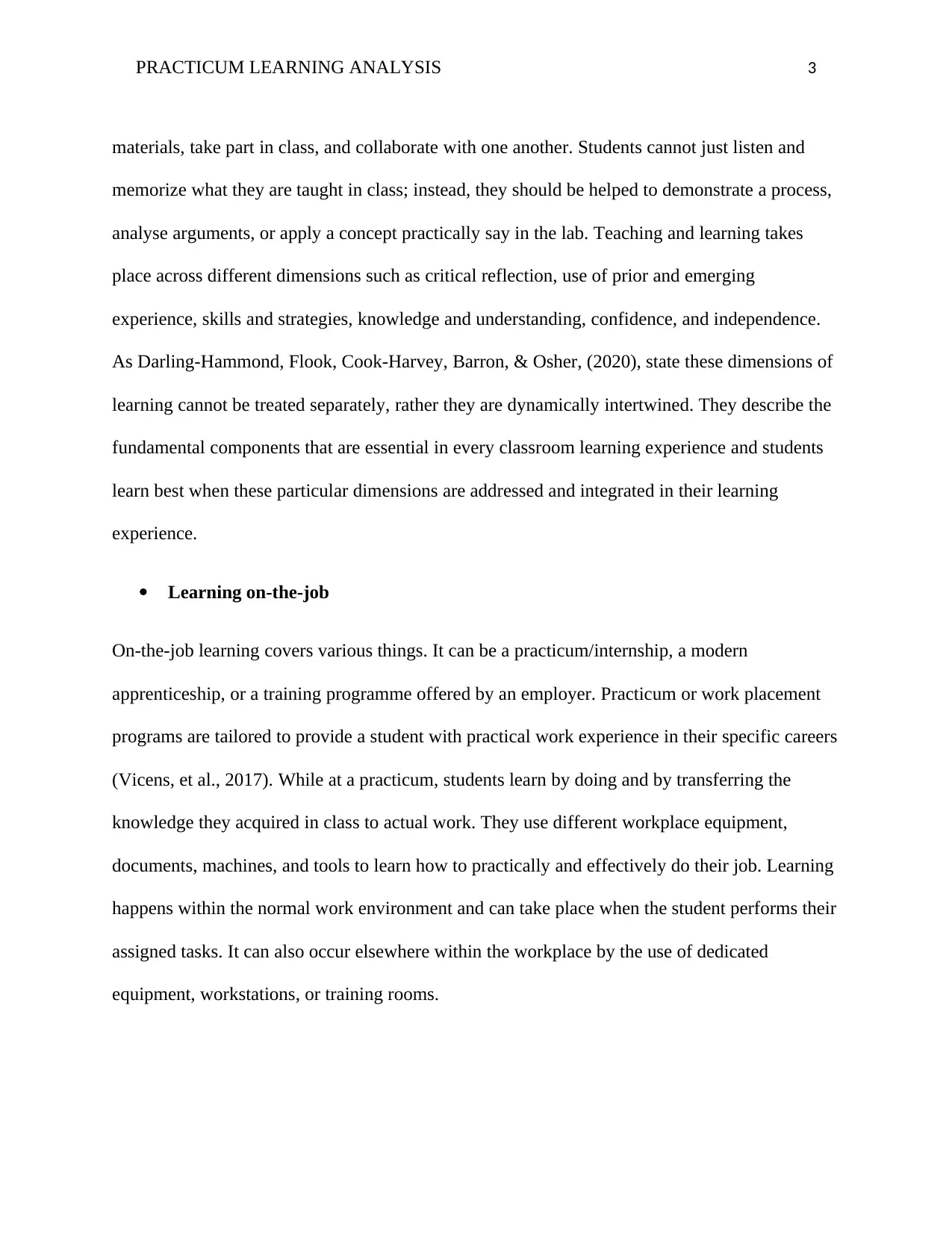
PRACTICUM LEARNING ANALYSIS 3
materials, take part in class, and collaborate with one another. Students cannot just listen and
memorize what they are taught in class; instead, they should be helped to demonstrate a process,
analyse arguments, or apply a concept practically say in the lab. Teaching and learning takes
place across different dimensions such as critical reflection, use of prior and emerging
experience, skills and strategies, knowledge and understanding, confidence, and independence.
As Darling-Hammond, Flook, Cook-Harvey, Barron, & Osher, (2020), state these dimensions of
learning cannot be treated separately, rather they are dynamically intertwined. They describe the
fundamental components that are essential in every classroom learning experience and students
learn best when these particular dimensions are addressed and integrated in their learning
experience.
Learning on-the-job
On-the-job learning covers various things. It can be a practicum/internship, a modern
apprenticeship, or a training programme offered by an employer. Practicum or work placement
programs are tailored to provide a student with practical work experience in their specific careers
(Vicens, et al., 2017). While at a practicum, students learn by doing and by transferring the
knowledge they acquired in class to actual work. They use different workplace equipment,
documents, machines, and tools to learn how to practically and effectively do their job. Learning
happens within the normal work environment and can take place when the student performs their
assigned tasks. It can also occur elsewhere within the workplace by the use of dedicated
equipment, workstations, or training rooms.
materials, take part in class, and collaborate with one another. Students cannot just listen and
memorize what they are taught in class; instead, they should be helped to demonstrate a process,
analyse arguments, or apply a concept practically say in the lab. Teaching and learning takes
place across different dimensions such as critical reflection, use of prior and emerging
experience, skills and strategies, knowledge and understanding, confidence, and independence.
As Darling-Hammond, Flook, Cook-Harvey, Barron, & Osher, (2020), state these dimensions of
learning cannot be treated separately, rather they are dynamically intertwined. They describe the
fundamental components that are essential in every classroom learning experience and students
learn best when these particular dimensions are addressed and integrated in their learning
experience.
Learning on-the-job
On-the-job learning covers various things. It can be a practicum/internship, a modern
apprenticeship, or a training programme offered by an employer. Practicum or work placement
programs are tailored to provide a student with practical work experience in their specific careers
(Vicens, et al., 2017). While at a practicum, students learn by doing and by transferring the
knowledge they acquired in class to actual work. They use different workplace equipment,
documents, machines, and tools to learn how to practically and effectively do their job. Learning
happens within the normal work environment and can take place when the student performs their
assigned tasks. It can also occur elsewhere within the workplace by the use of dedicated
equipment, workstations, or training rooms.
⊘ This is a preview!⊘
Do you want full access?
Subscribe today to unlock all pages.

Trusted by 1+ million students worldwide
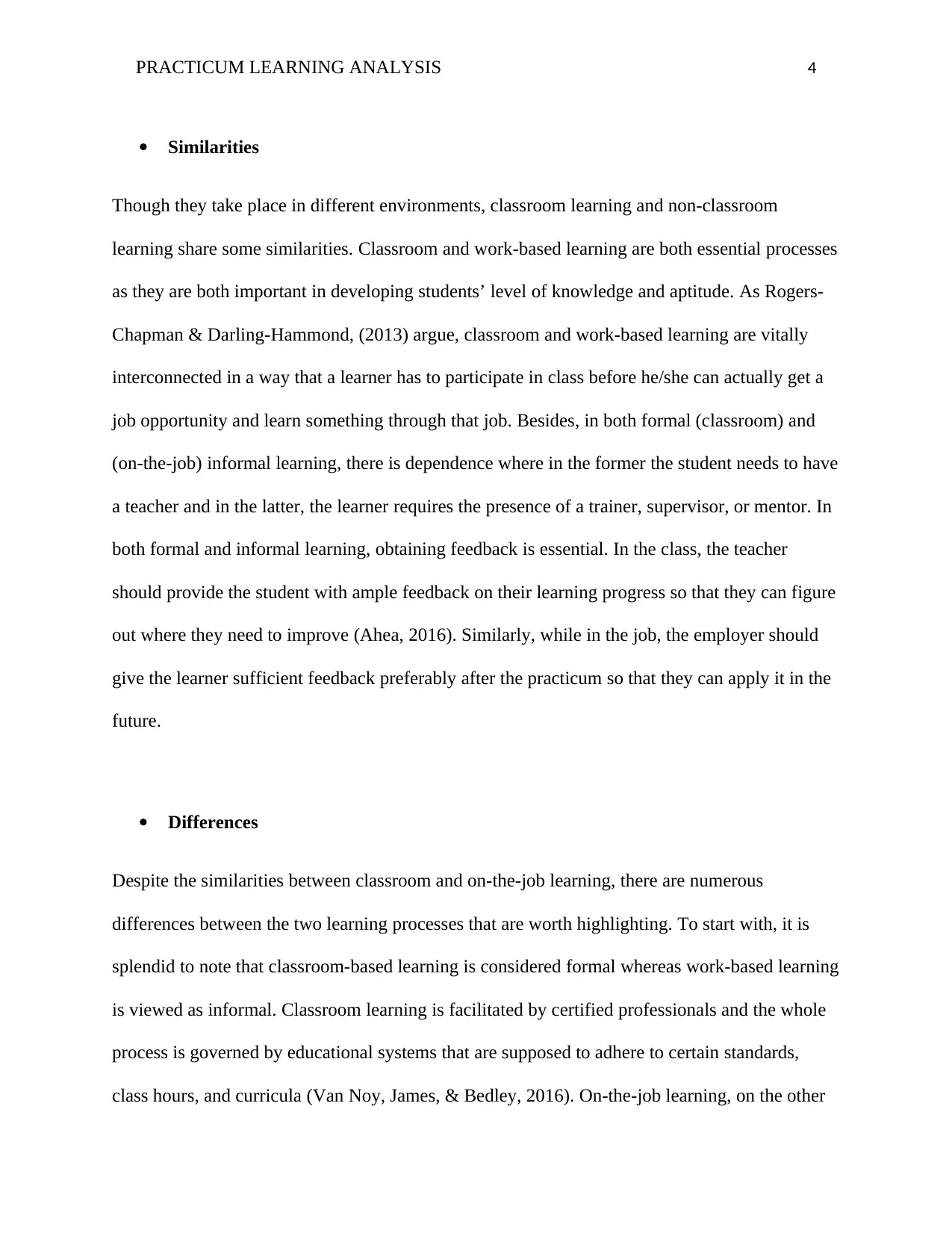
PRACTICUM LEARNING ANALYSIS 4
Similarities
Though they take place in different environments, classroom learning and non-classroom
learning share some similarities. Classroom and work-based learning are both essential processes
as they are both important in developing students’ level of knowledge and aptitude. As Rogers-
Chapman & Darling-Hammond, (2013) argue, classroom and work-based learning are vitally
interconnected in a way that a learner has to participate in class before he/she can actually get a
job opportunity and learn something through that job. Besides, in both formal (classroom) and
(on-the-job) informal learning, there is dependence where in the former the student needs to have
a teacher and in the latter, the learner requires the presence of a trainer, supervisor, or mentor. In
both formal and informal learning, obtaining feedback is essential. In the class, the teacher
should provide the student with ample feedback on their learning progress so that they can figure
out where they need to improve (Ahea, 2016). Similarly, while in the job, the employer should
give the learner sufficient feedback preferably after the practicum so that they can apply it in the
future.
Differences
Despite the similarities between classroom and on-the-job learning, there are numerous
differences between the two learning processes that are worth highlighting. To start with, it is
splendid to note that classroom-based learning is considered formal whereas work-based learning
is viewed as informal. Classroom learning is facilitated by certified professionals and the whole
process is governed by educational systems that are supposed to adhere to certain standards,
class hours, and curricula (Van Noy, James, & Bedley, 2016). On-the-job learning, on the other
Similarities
Though they take place in different environments, classroom learning and non-classroom
learning share some similarities. Classroom and work-based learning are both essential processes
as they are both important in developing students’ level of knowledge and aptitude. As Rogers-
Chapman & Darling-Hammond, (2013) argue, classroom and work-based learning are vitally
interconnected in a way that a learner has to participate in class before he/she can actually get a
job opportunity and learn something through that job. Besides, in both formal (classroom) and
(on-the-job) informal learning, there is dependence where in the former the student needs to have
a teacher and in the latter, the learner requires the presence of a trainer, supervisor, or mentor. In
both formal and informal learning, obtaining feedback is essential. In the class, the teacher
should provide the student with ample feedback on their learning progress so that they can figure
out where they need to improve (Ahea, 2016). Similarly, while in the job, the employer should
give the learner sufficient feedback preferably after the practicum so that they can apply it in the
future.
Differences
Despite the similarities between classroom and on-the-job learning, there are numerous
differences between the two learning processes that are worth highlighting. To start with, it is
splendid to note that classroom-based learning is considered formal whereas work-based learning
is viewed as informal. Classroom learning is facilitated by certified professionals and the whole
process is governed by educational systems that are supposed to adhere to certain standards,
class hours, and curricula (Van Noy, James, & Bedley, 2016). On-the-job learning, on the other
Paraphrase This Document
Need a fresh take? Get an instant paraphrase of this document with our AI Paraphraser
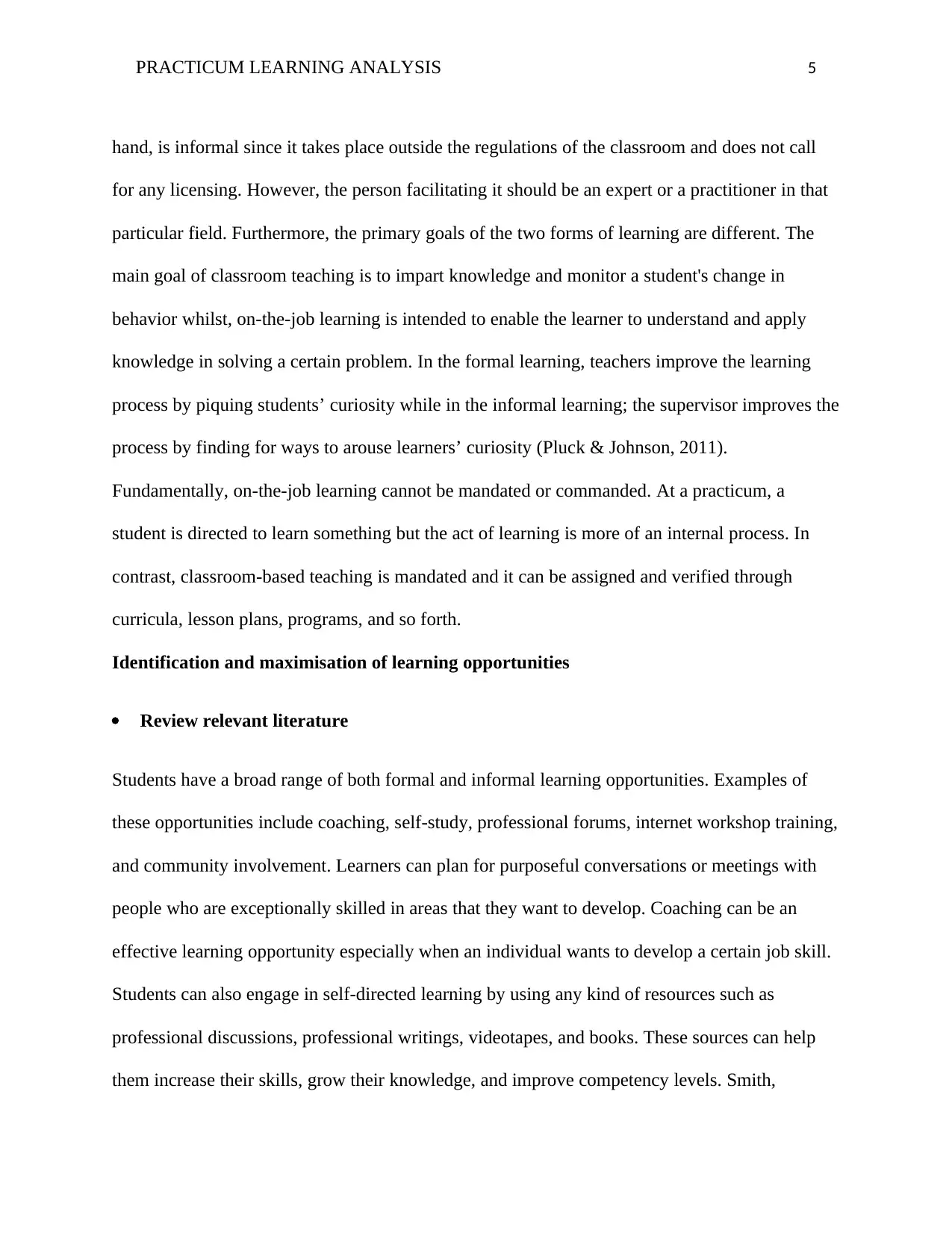
PRACTICUM LEARNING ANALYSIS 5
hand, is informal since it takes place outside the regulations of the classroom and does not call
for any licensing. However, the person facilitating it should be an expert or a practitioner in that
particular field. Furthermore, the primary goals of the two forms of learning are different. The
main goal of classroom teaching is to impart knowledge and monitor a student's change in
behavior whilst, on-the-job learning is intended to enable the learner to understand and apply
knowledge in solving a certain problem. In the formal learning, teachers improve the learning
process by piquing students’ curiosity while in the informal learning; the supervisor improves the
process by finding for ways to arouse learners’ curiosity (Pluck & Johnson, 2011).
Fundamentally, on-the-job learning cannot be mandated or commanded. At a practicum, a
student is directed to learn something but the act of learning is more of an internal process. In
contrast, classroom-based teaching is mandated and it can be assigned and verified through
curricula, lesson plans, programs, and so forth.
Identification and maximisation of learning opportunities
Review relevant literature
Students have a broad range of both formal and informal learning opportunities. Examples of
these opportunities include coaching, self-study, professional forums, internet workshop training,
and community involvement. Learners can plan for purposeful conversations or meetings with
people who are exceptionally skilled in areas that they want to develop. Coaching can be an
effective learning opportunity especially when an individual wants to develop a certain job skill.
Students can also engage in self-directed learning by using any kind of resources such as
professional discussions, professional writings, videotapes, and books. These sources can help
them increase their skills, grow their knowledge, and improve competency levels. Smith,
hand, is informal since it takes place outside the regulations of the classroom and does not call
for any licensing. However, the person facilitating it should be an expert or a practitioner in that
particular field. Furthermore, the primary goals of the two forms of learning are different. The
main goal of classroom teaching is to impart knowledge and monitor a student's change in
behavior whilst, on-the-job learning is intended to enable the learner to understand and apply
knowledge in solving a certain problem. In the formal learning, teachers improve the learning
process by piquing students’ curiosity while in the informal learning; the supervisor improves the
process by finding for ways to arouse learners’ curiosity (Pluck & Johnson, 2011).
Fundamentally, on-the-job learning cannot be mandated or commanded. At a practicum, a
student is directed to learn something but the act of learning is more of an internal process. In
contrast, classroom-based teaching is mandated and it can be assigned and verified through
curricula, lesson plans, programs, and so forth.
Identification and maximisation of learning opportunities
Review relevant literature
Students have a broad range of both formal and informal learning opportunities. Examples of
these opportunities include coaching, self-study, professional forums, internet workshop training,
and community involvement. Learners can plan for purposeful conversations or meetings with
people who are exceptionally skilled in areas that they want to develop. Coaching can be an
effective learning opportunity especially when an individual wants to develop a certain job skill.
Students can also engage in self-directed learning by using any kind of resources such as
professional discussions, professional writings, videotapes, and books. These sources can help
them increase their skills, grow their knowledge, and improve competency levels. Smith,
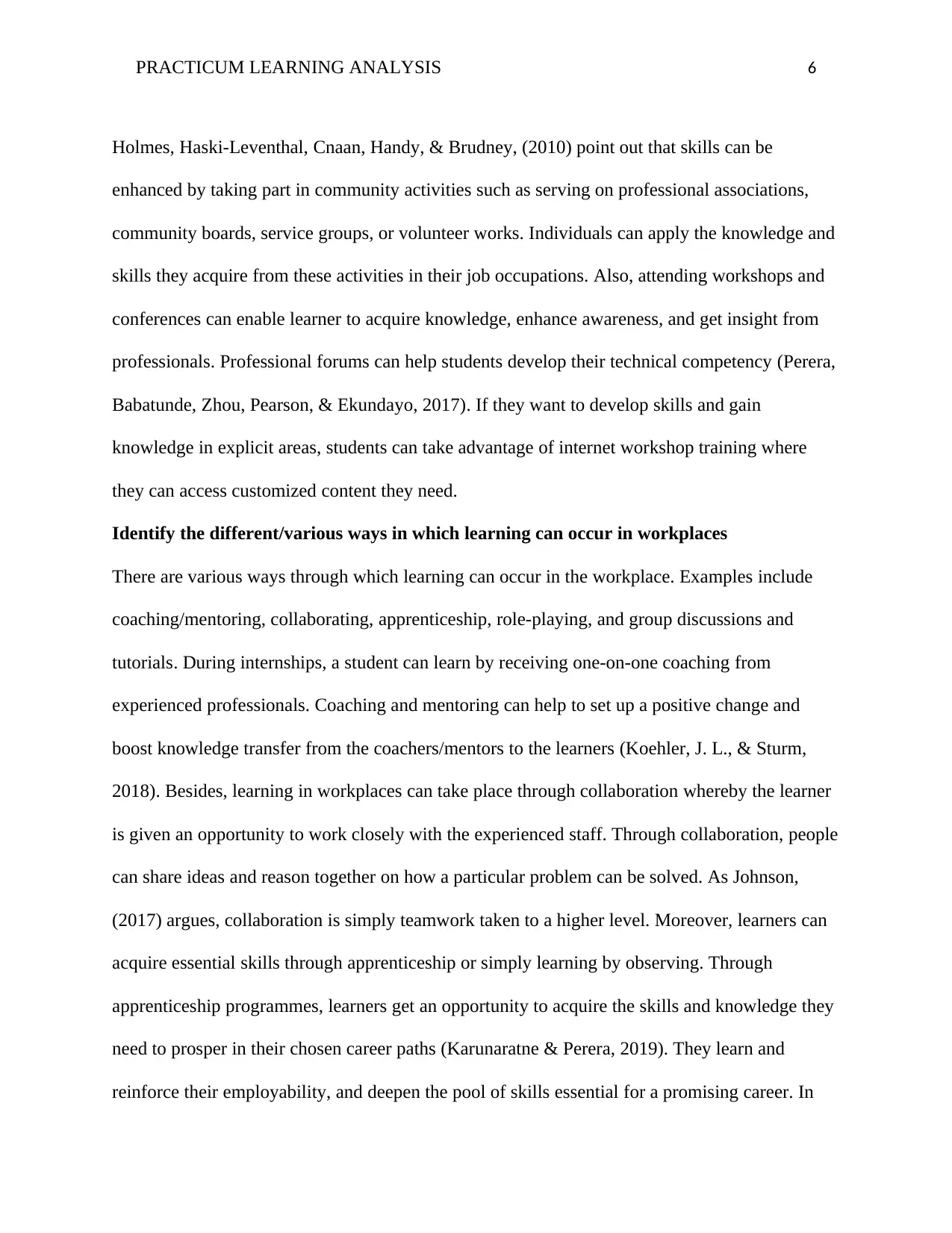
PRACTICUM LEARNING ANALYSIS 6
Holmes, Haski-Leventhal, Cnaan, Handy, & Brudney, (2010) point out that skills can be
enhanced by taking part in community activities such as serving on professional associations,
community boards, service groups, or volunteer works. Individuals can apply the knowledge and
skills they acquire from these activities in their job occupations. Also, attending workshops and
conferences can enable learner to acquire knowledge, enhance awareness, and get insight from
professionals. Professional forums can help students develop their technical competency (Perera,
Babatunde, Zhou, Pearson, & Ekundayo, 2017). If they want to develop skills and gain
knowledge in explicit areas, students can take advantage of internet workshop training where
they can access customized content they need.
Identify the different/various ways in which learning can occur in workplaces
There are various ways through which learning can occur in the workplace. Examples include
coaching/mentoring, collaborating, apprenticeship, role-playing, and group discussions and
tutorials. During internships, a student can learn by receiving one-on-one coaching from
experienced professionals. Coaching and mentoring can help to set up a positive change and
boost knowledge transfer from the coachers/mentors to the learners (Koehler, J. L., & Sturm,
2018). Besides, learning in workplaces can take place through collaboration whereby the learner
is given an opportunity to work closely with the experienced staff. Through collaboration, people
can share ideas and reason together on how a particular problem can be solved. As Johnson,
(2017) argues, collaboration is simply teamwork taken to a higher level. Moreover, learners can
acquire essential skills through apprenticeship or simply learning by observing. Through
apprenticeship programmes, learners get an opportunity to acquire the skills and knowledge they
need to prosper in their chosen career paths (Karunaratne & Perera, 2019). They learn and
reinforce their employability, and deepen the pool of skills essential for a promising career. In
Holmes, Haski-Leventhal, Cnaan, Handy, & Brudney, (2010) point out that skills can be
enhanced by taking part in community activities such as serving on professional associations,
community boards, service groups, or volunteer works. Individuals can apply the knowledge and
skills they acquire from these activities in their job occupations. Also, attending workshops and
conferences can enable learner to acquire knowledge, enhance awareness, and get insight from
professionals. Professional forums can help students develop their technical competency (Perera,
Babatunde, Zhou, Pearson, & Ekundayo, 2017). If they want to develop skills and gain
knowledge in explicit areas, students can take advantage of internet workshop training where
they can access customized content they need.
Identify the different/various ways in which learning can occur in workplaces
There are various ways through which learning can occur in the workplace. Examples include
coaching/mentoring, collaborating, apprenticeship, role-playing, and group discussions and
tutorials. During internships, a student can learn by receiving one-on-one coaching from
experienced professionals. Coaching and mentoring can help to set up a positive change and
boost knowledge transfer from the coachers/mentors to the learners (Koehler, J. L., & Sturm,
2018). Besides, learning in workplaces can take place through collaboration whereby the learner
is given an opportunity to work closely with the experienced staff. Through collaboration, people
can share ideas and reason together on how a particular problem can be solved. As Johnson,
(2017) argues, collaboration is simply teamwork taken to a higher level. Moreover, learners can
acquire essential skills through apprenticeship or simply learning by observing. Through
apprenticeship programmes, learners get an opportunity to acquire the skills and knowledge they
need to prosper in their chosen career paths (Karunaratne & Perera, 2019). They learn and
reinforce their employability, and deepen the pool of skills essential for a promising career. In
⊘ This is a preview!⊘
Do you want full access?
Subscribe today to unlock all pages.

Trusted by 1+ million students worldwide
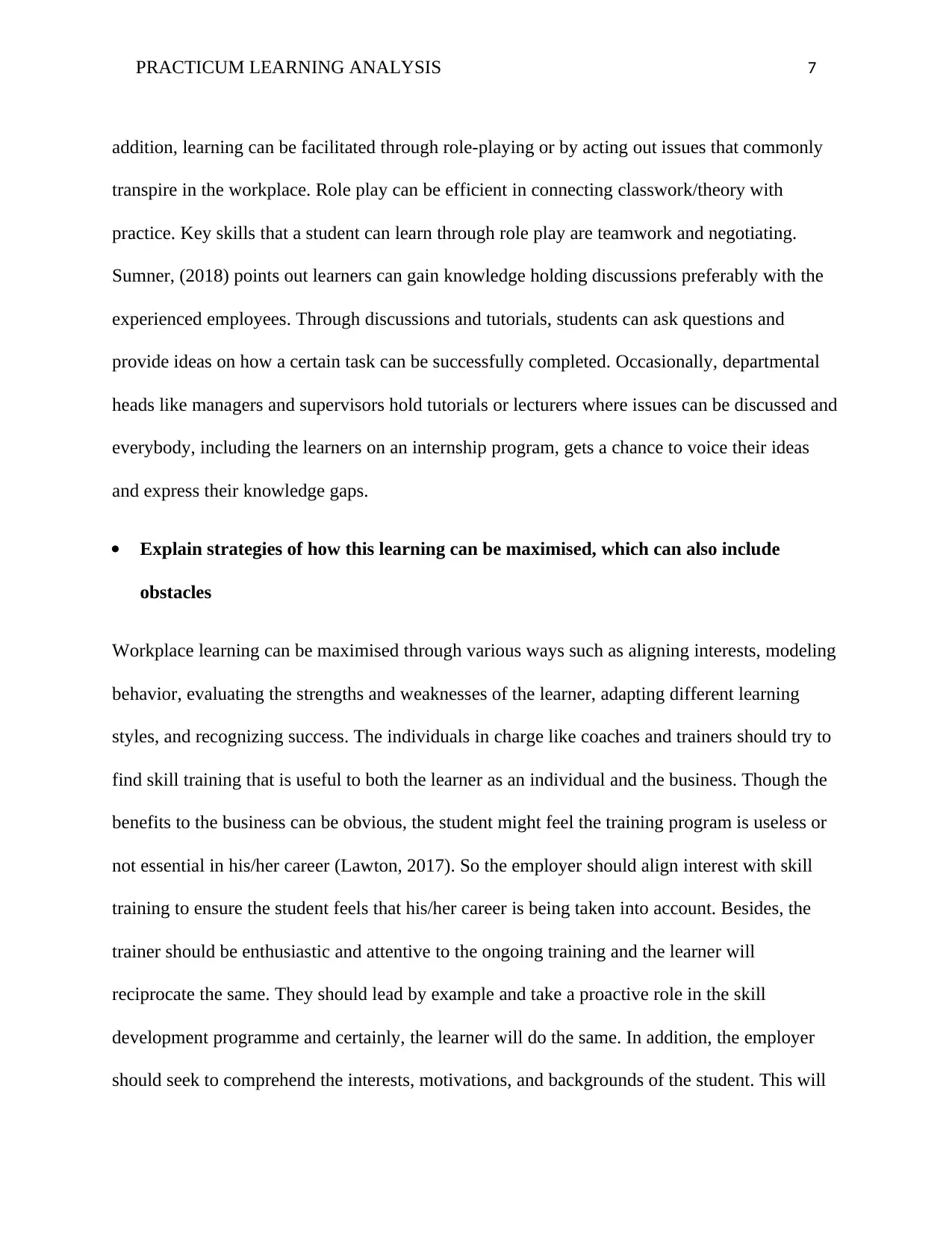
PRACTICUM LEARNING ANALYSIS 7
addition, learning can be facilitated through role-playing or by acting out issues that commonly
transpire in the workplace. Role play can be efficient in connecting classwork/theory with
practice. Key skills that a student can learn through role play are teamwork and negotiating.
Sumner, (2018) points out learners can gain knowledge holding discussions preferably with the
experienced employees. Through discussions and tutorials, students can ask questions and
provide ideas on how a certain task can be successfully completed. Occasionally, departmental
heads like managers and supervisors hold tutorials or lecturers where issues can be discussed and
everybody, including the learners on an internship program, gets a chance to voice their ideas
and express their knowledge gaps.
Explain strategies of how this learning can be maximised, which can also include
obstacles
Workplace learning can be maximised through various ways such as aligning interests, modeling
behavior, evaluating the strengths and weaknesses of the learner, adapting different learning
styles, and recognizing success. The individuals in charge like coaches and trainers should try to
find skill training that is useful to both the learner as an individual and the business. Though the
benefits to the business can be obvious, the student might feel the training program is useless or
not essential in his/her career (Lawton, 2017). So the employer should align interest with skill
training to ensure the student feels that his/her career is being taken into account. Besides, the
trainer should be enthusiastic and attentive to the ongoing training and the learner will
reciprocate the same. They should lead by example and take a proactive role in the skill
development programme and certainly, the learner will do the same. In addition, the employer
should seek to comprehend the interests, motivations, and backgrounds of the student. This will
addition, learning can be facilitated through role-playing or by acting out issues that commonly
transpire in the workplace. Role play can be efficient in connecting classwork/theory with
practice. Key skills that a student can learn through role play are teamwork and negotiating.
Sumner, (2018) points out learners can gain knowledge holding discussions preferably with the
experienced employees. Through discussions and tutorials, students can ask questions and
provide ideas on how a certain task can be successfully completed. Occasionally, departmental
heads like managers and supervisors hold tutorials or lecturers where issues can be discussed and
everybody, including the learners on an internship program, gets a chance to voice their ideas
and express their knowledge gaps.
Explain strategies of how this learning can be maximised, which can also include
obstacles
Workplace learning can be maximised through various ways such as aligning interests, modeling
behavior, evaluating the strengths and weaknesses of the learner, adapting different learning
styles, and recognizing success. The individuals in charge like coaches and trainers should try to
find skill training that is useful to both the learner as an individual and the business. Though the
benefits to the business can be obvious, the student might feel the training program is useless or
not essential in his/her career (Lawton, 2017). So the employer should align interest with skill
training to ensure the student feels that his/her career is being taken into account. Besides, the
trainer should be enthusiastic and attentive to the ongoing training and the learner will
reciprocate the same. They should lead by example and take a proactive role in the skill
development programme and certainly, the learner will do the same. In addition, the employer
should seek to comprehend the interests, motivations, and backgrounds of the student. This will
Paraphrase This Document
Need a fresh take? Get an instant paraphrase of this document with our AI Paraphraser
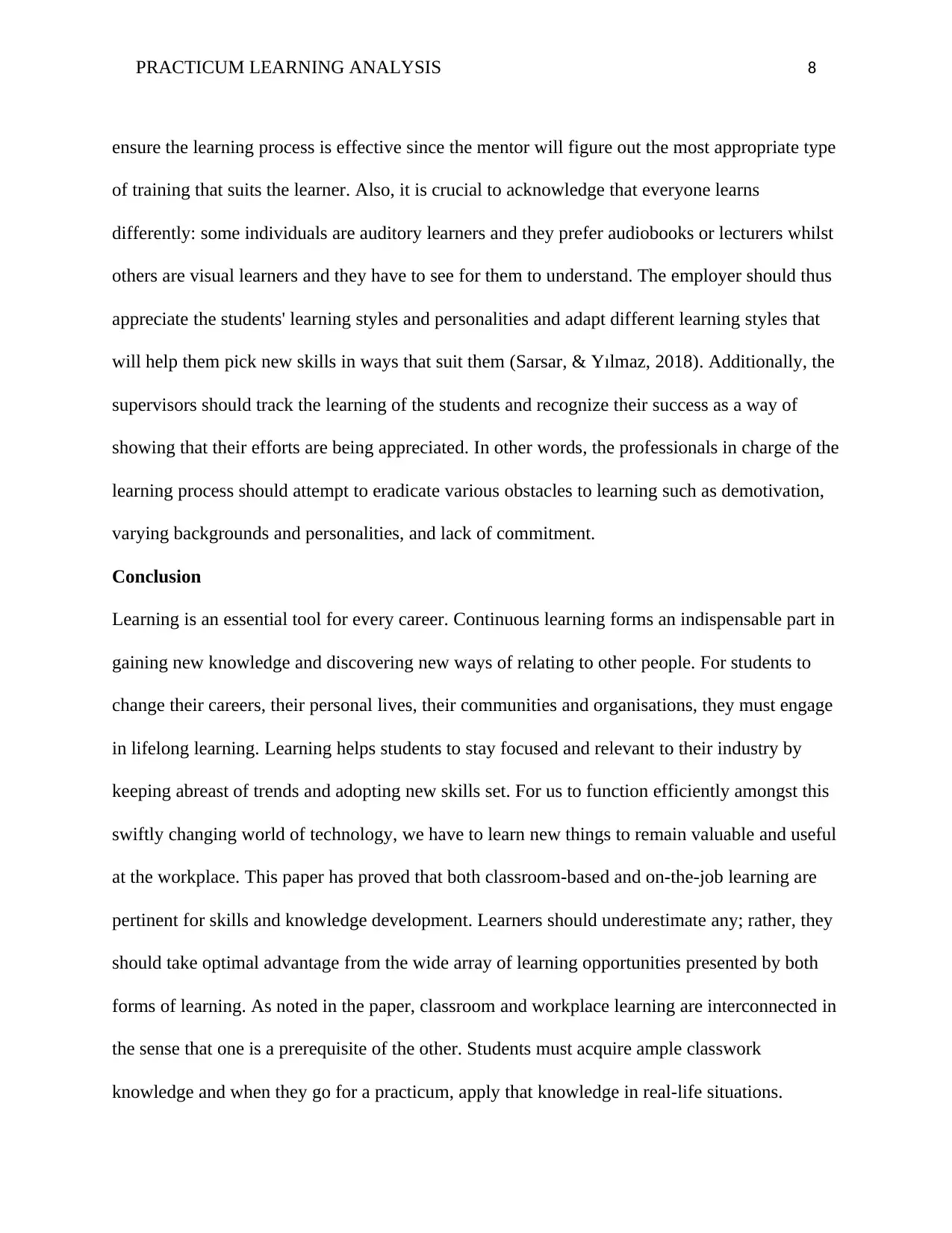
PRACTICUM LEARNING ANALYSIS 8
ensure the learning process is effective since the mentor will figure out the most appropriate type
of training that suits the learner. Also, it is crucial to acknowledge that everyone learns
differently: some individuals are auditory learners and they prefer audiobooks or lecturers whilst
others are visual learners and they have to see for them to understand. The employer should thus
appreciate the students' learning styles and personalities and adapt different learning styles that
will help them pick new skills in ways that suit them (Sarsar, & Yılmaz, 2018). Additionally, the
supervisors should track the learning of the students and recognize their success as a way of
showing that their efforts are being appreciated. In other words, the professionals in charge of the
learning process should attempt to eradicate various obstacles to learning such as demotivation,
varying backgrounds and personalities, and lack of commitment.
Conclusion
Learning is an essential tool for every career. Continuous learning forms an indispensable part in
gaining new knowledge and discovering new ways of relating to other people. For students to
change their careers, their personal lives, their communities and organisations, they must engage
in lifelong learning. Learning helps students to stay focused and relevant to their industry by
keeping abreast of trends and adopting new skills set. For us to function efficiently amongst this
swiftly changing world of technology, we have to learn new things to remain valuable and useful
at the workplace. This paper has proved that both classroom-based and on-the-job learning are
pertinent for skills and knowledge development. Learners should underestimate any; rather, they
should take optimal advantage from the wide array of learning opportunities presented by both
forms of learning. As noted in the paper, classroom and workplace learning are interconnected in
the sense that one is a prerequisite of the other. Students must acquire ample classwork
knowledge and when they go for a practicum, apply that knowledge in real-life situations.
ensure the learning process is effective since the mentor will figure out the most appropriate type
of training that suits the learner. Also, it is crucial to acknowledge that everyone learns
differently: some individuals are auditory learners and they prefer audiobooks or lecturers whilst
others are visual learners and they have to see for them to understand. The employer should thus
appreciate the students' learning styles and personalities and adapt different learning styles that
will help them pick new skills in ways that suit them (Sarsar, & Yılmaz, 2018). Additionally, the
supervisors should track the learning of the students and recognize their success as a way of
showing that their efforts are being appreciated. In other words, the professionals in charge of the
learning process should attempt to eradicate various obstacles to learning such as demotivation,
varying backgrounds and personalities, and lack of commitment.
Conclusion
Learning is an essential tool for every career. Continuous learning forms an indispensable part in
gaining new knowledge and discovering new ways of relating to other people. For students to
change their careers, their personal lives, their communities and organisations, they must engage
in lifelong learning. Learning helps students to stay focused and relevant to their industry by
keeping abreast of trends and adopting new skills set. For us to function efficiently amongst this
swiftly changing world of technology, we have to learn new things to remain valuable and useful
at the workplace. This paper has proved that both classroom-based and on-the-job learning are
pertinent for skills and knowledge development. Learners should underestimate any; rather, they
should take optimal advantage from the wide array of learning opportunities presented by both
forms of learning. As noted in the paper, classroom and workplace learning are interconnected in
the sense that one is a prerequisite of the other. Students must acquire ample classwork
knowledge and when they go for a practicum, apply that knowledge in real-life situations.
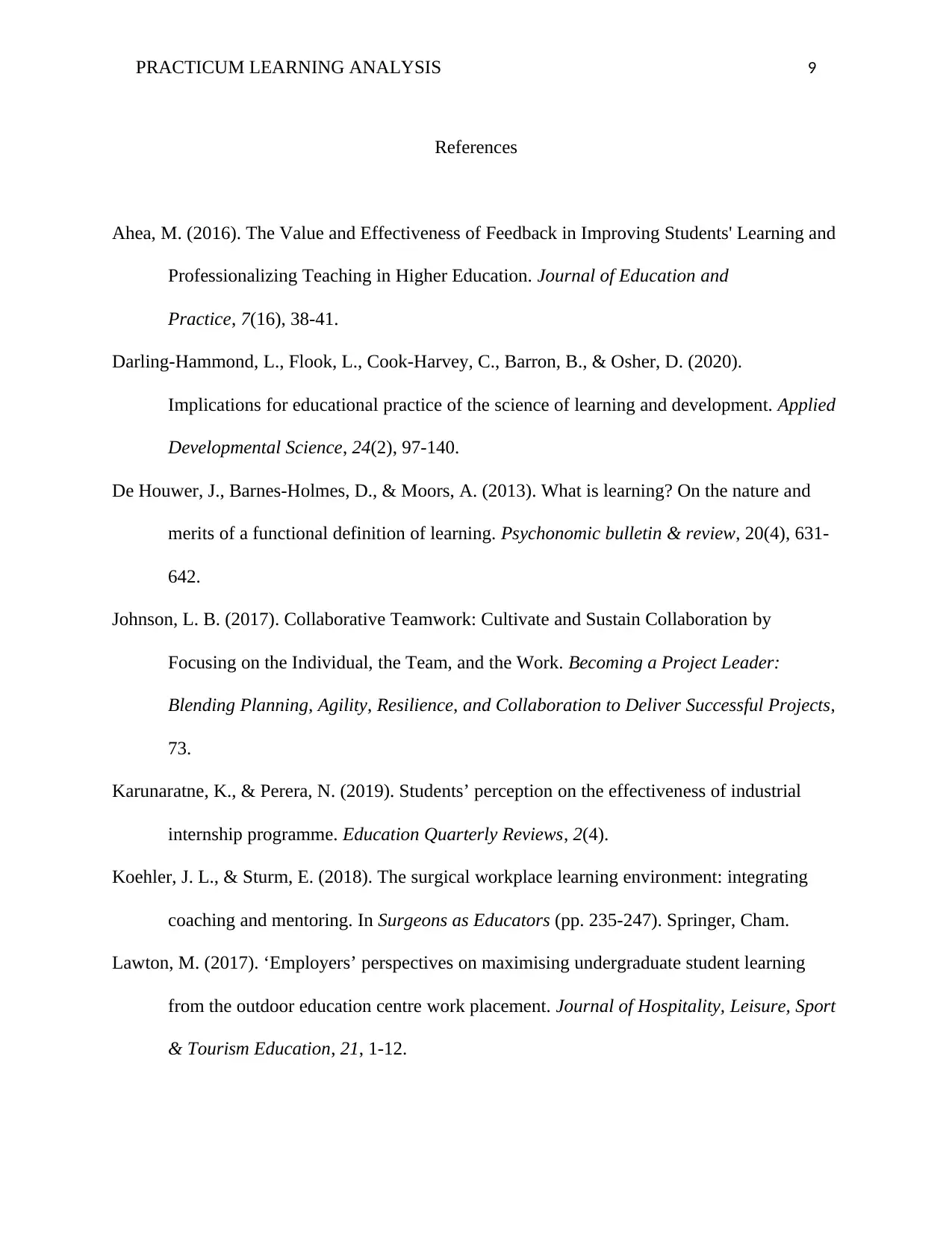
PRACTICUM LEARNING ANALYSIS 9
References
Ahea, M. (2016). The Value and Effectiveness of Feedback in Improving Students' Learning and
Professionalizing Teaching in Higher Education. Journal of Education and
Practice, 7(16), 38-41.
Darling-Hammond, L., Flook, L., Cook-Harvey, C., Barron, B., & Osher, D. (2020).
Implications for educational practice of the science of learning and development. Applied
Developmental Science, 24(2), 97-140.
De Houwer, J., Barnes-Holmes, D., & Moors, A. (2013). What is learning? On the nature and
merits of a functional definition of learning. Psychonomic bulletin & review, 20(4), 631-
642.
Johnson, L. B. (2017). Collaborative Teamwork: Cultivate and Sustain Collaboration by
Focusing on the Individual, the Team, and the Work. Becoming a Project Leader:
Blending Planning, Agility, Resilience, and Collaboration to Deliver Successful Projects,
73.
Karunaratne, K., & Perera, N. (2019). Students’ perception on the effectiveness of industrial
internship programme. Education Quarterly Reviews, 2(4).
Koehler, J. L., & Sturm, E. (2018). The surgical workplace learning environment: integrating
coaching and mentoring. In Surgeons as Educators (pp. 235-247). Springer, Cham.
Lawton, M. (2017). ‘Employers’ perspectives on maximising undergraduate student learning
from the outdoor education centre work placement. Journal of Hospitality, Leisure, Sport
& Tourism Education, 21, 1-12.
References
Ahea, M. (2016). The Value and Effectiveness of Feedback in Improving Students' Learning and
Professionalizing Teaching in Higher Education. Journal of Education and
Practice, 7(16), 38-41.
Darling-Hammond, L., Flook, L., Cook-Harvey, C., Barron, B., & Osher, D. (2020).
Implications for educational practice of the science of learning and development. Applied
Developmental Science, 24(2), 97-140.
De Houwer, J., Barnes-Holmes, D., & Moors, A. (2013). What is learning? On the nature and
merits of a functional definition of learning. Psychonomic bulletin & review, 20(4), 631-
642.
Johnson, L. B. (2017). Collaborative Teamwork: Cultivate and Sustain Collaboration by
Focusing on the Individual, the Team, and the Work. Becoming a Project Leader:
Blending Planning, Agility, Resilience, and Collaboration to Deliver Successful Projects,
73.
Karunaratne, K., & Perera, N. (2019). Students’ perception on the effectiveness of industrial
internship programme. Education Quarterly Reviews, 2(4).
Koehler, J. L., & Sturm, E. (2018). The surgical workplace learning environment: integrating
coaching and mentoring. In Surgeons as Educators (pp. 235-247). Springer, Cham.
Lawton, M. (2017). ‘Employers’ perspectives on maximising undergraduate student learning
from the outdoor education centre work placement. Journal of Hospitality, Leisure, Sport
& Tourism Education, 21, 1-12.
⊘ This is a preview!⊘
Do you want full access?
Subscribe today to unlock all pages.

Trusted by 1+ million students worldwide
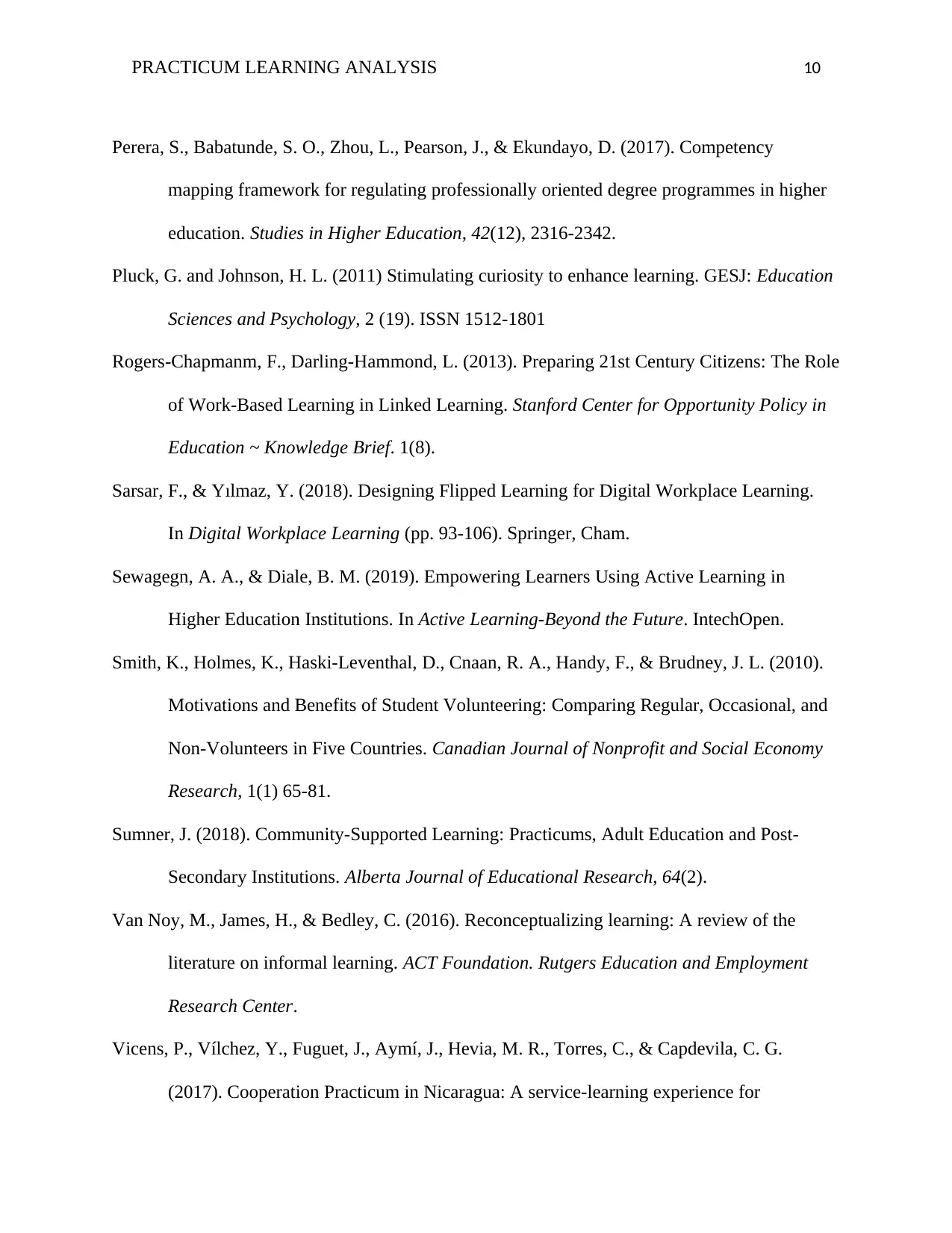
PRACTICUM LEARNING ANALYSIS 10
Perera, S., Babatunde, S. O., Zhou, L., Pearson, J., & Ekundayo, D. (2017). Competency
mapping framework for regulating professionally oriented degree programmes in higher
education. Studies in Higher Education, 42(12), 2316-2342.
Pluck, G. and Johnson, H. L. (2011) Stimulating curiosity to enhance learning. GESJ: Education
Sciences and Psychology, 2 (19). ISSN 1512-1801
Rogers-Chapmanm, F., Darling-Hammond, L. (2013). Preparing 21st Century Citizens: The Role
of Work-Based Learning in Linked Learning. Stanford Center for Opportunity Policy in
Education ~ Knowledge Brief. 1(8).
Sarsar, F., & Yılmaz, Y. (2018). Designing Flipped Learning for Digital Workplace Learning.
In Digital Workplace Learning (pp. 93-106). Springer, Cham.
Sewagegn, A. A., & Diale, B. M. (2019). Empowering Learners Using Active Learning in
Higher Education Institutions. In Active Learning-Beyond the Future. IntechOpen.
Smith, K., Holmes, K., Haski-Leventhal, D., Cnaan, R. A., Handy, F., & Brudney, J. L. (2010).
Motivations and Benefits of Student Volunteering: Comparing Regular, Occasional, and
Non-Volunteers in Five Countries. Canadian Journal of Nonprofit and Social Economy
Research, 1(1) 65-81.
Sumner, J. (2018). Community-Supported Learning: Practicums, Adult Education and Post-
Secondary Institutions. Alberta Journal of Educational Research, 64(2).
Van Noy, M., James, H., & Bedley, C. (2016). Reconceptualizing learning: A review of the
literature on informal learning. ACT Foundation. Rutgers Education and Employment
Research Center.
Vicens, P., Vílchez, Y., Fuguet, J., Aymí, J., Hevia, M. R., Torres, C., & Capdevila, C. G.
(2017). Cooperation Practicum in Nicaragua: A service-learning experience for
Perera, S., Babatunde, S. O., Zhou, L., Pearson, J., & Ekundayo, D. (2017). Competency
mapping framework for regulating professionally oriented degree programmes in higher
education. Studies in Higher Education, 42(12), 2316-2342.
Pluck, G. and Johnson, H. L. (2011) Stimulating curiosity to enhance learning. GESJ: Education
Sciences and Psychology, 2 (19). ISSN 1512-1801
Rogers-Chapmanm, F., Darling-Hammond, L. (2013). Preparing 21st Century Citizens: The Role
of Work-Based Learning in Linked Learning. Stanford Center for Opportunity Policy in
Education ~ Knowledge Brief. 1(8).
Sarsar, F., & Yılmaz, Y. (2018). Designing Flipped Learning for Digital Workplace Learning.
In Digital Workplace Learning (pp. 93-106). Springer, Cham.
Sewagegn, A. A., & Diale, B. M. (2019). Empowering Learners Using Active Learning in
Higher Education Institutions. In Active Learning-Beyond the Future. IntechOpen.
Smith, K., Holmes, K., Haski-Leventhal, D., Cnaan, R. A., Handy, F., & Brudney, J. L. (2010).
Motivations and Benefits of Student Volunteering: Comparing Regular, Occasional, and
Non-Volunteers in Five Countries. Canadian Journal of Nonprofit and Social Economy
Research, 1(1) 65-81.
Sumner, J. (2018). Community-Supported Learning: Practicums, Adult Education and Post-
Secondary Institutions. Alberta Journal of Educational Research, 64(2).
Van Noy, M., James, H., & Bedley, C. (2016). Reconceptualizing learning: A review of the
literature on informal learning. ACT Foundation. Rutgers Education and Employment
Research Center.
Vicens, P., Vílchez, Y., Fuguet, J., Aymí, J., Hevia, M. R., Torres, C., & Capdevila, C. G.
(2017). Cooperation Practicum in Nicaragua: A service-learning experience for
Paraphrase This Document
Need a fresh take? Get an instant paraphrase of this document with our AI Paraphraser

PRACTICUM LEARNING ANALYSIS 11
completing the work placement and degree final project in the Faculty of Educational
Sciences and Psychology. Comprehensive Internationalisation at the URV: Examples of
Good Practices at the Universitat Rovira i Virgili, 82, 189.
completing the work placement and degree final project in the Faculty of Educational
Sciences and Psychology. Comprehensive Internationalisation at the URV: Examples of
Good Practices at the Universitat Rovira i Virgili, 82, 189.
1 out of 11
Related Documents
Your All-in-One AI-Powered Toolkit for Academic Success.
+13062052269
info@desklib.com
Available 24*7 on WhatsApp / Email
![[object Object]](/_next/static/media/star-bottom.7253800d.svg)
Unlock your academic potential
Copyright © 2020–2025 A2Z Services. All Rights Reserved. Developed and managed by ZUCOL.




